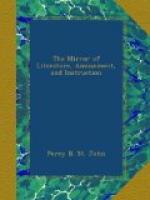bank of the Thames,’[3] the site of which is
still marked by Strand Lane. Not far from the
bridge stood the Bishops of
Chester’s Inn
(’commonly called
Lichfield and
Couentrie.’[4]),
and adjoining it the Bishop of
Worcester’s
Inn, both of which were pulled down by the Protector
Somerset, in 1549, when he erected
Somerset House.[5]
Opposite the Bishop of Worcester’s Inn formerly
stood a stone cross, at which, says Stow, ’the
justices itinerants sate without London.’[6]
Near this spot afterwards was erected the
May Pole,
which was removed in 1713.[7] The next mansion was
the
Palace of the
Savoy, adjoining to
the walls of which were the gardens of the Bishop
Carlisle’s Inn, afterwards called
Worcester
House, now the site of Beaufort Buildings.
The next in succession was
Salisbury House,
which has given name to Salisbury and Cecil Streets.
Proceeding onwards, and passing over
Ivy Bridge,
the magnificent structure of
Durham House presented
itself, which at one period was a royal palace.
Nearly adjoining was an
Inn belonging to the
Bishops of
Norwich, afterwards called
York
House, from becoming the residence of the Archbishops
of York, when their former mansion at Whitehall was
converted into a royal palace by Henry the Eighth.
York Stairs, at the bottom of Buckingham Street, still
marks the water-gate of the estate, which subsequently
became the property of George Villiers, Duke of Buckingham,
whose names and titles are perpetuated in the various
streets, &c. built upon it. The last mansion near
the village of Charing, and now the only remaining
one, was called
Northampton House, afterwards
Suffolk House, and now
Northumberland House,
from being the residence of the Dukes of Northumberland.
“On the north side, the Strand presented but
few houses of note. Wimbledon House, on the
spot lately occupied by D’Oyley’s Warehouse,
which had been erected by Sir Edward Cecil, was burnt
down in 1628. At a little distance, westward,
was Burghley House, afterwards Exeter House,
and now partly occupied by Exeter ’Change; on
the other part, and its attached ground, were erected
the several streets and alleys receiving names from
the Cecil family.”
[1] That street was so called
in compliment to the celebrated
Lady
Rachel, daughter of Thomas Wriothesley, Earl of
Southampton,
and consort of William Lord Russell. Several
other
places in this parish were also denominated from either
the
names or titles of the Russell family—as
Russell
Street,
Bedford Street and Bury, Tavistock Street,
Chandos
Street, &c. King and Henrietta Streets
were so
named
in honour of Charles I. and his Queen; and James
and
York
Streets, of the Duke of York, afterwards James II.




